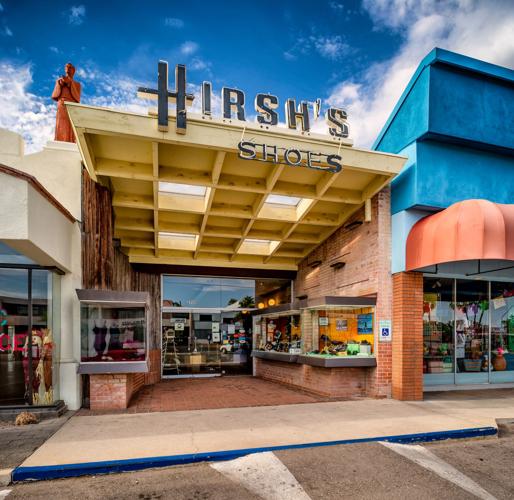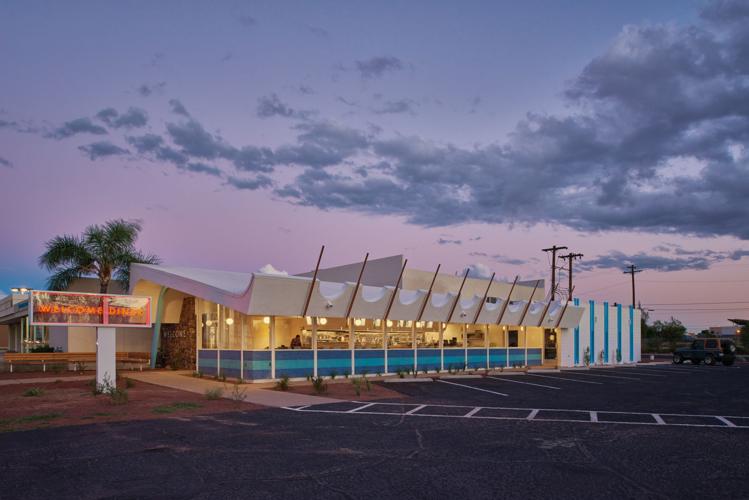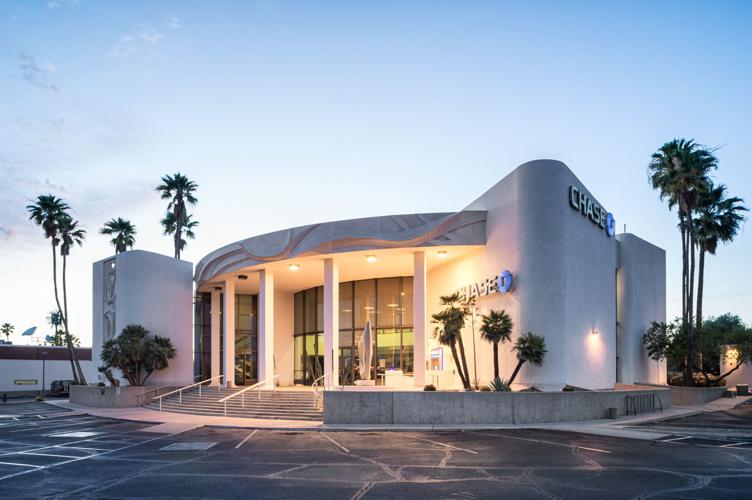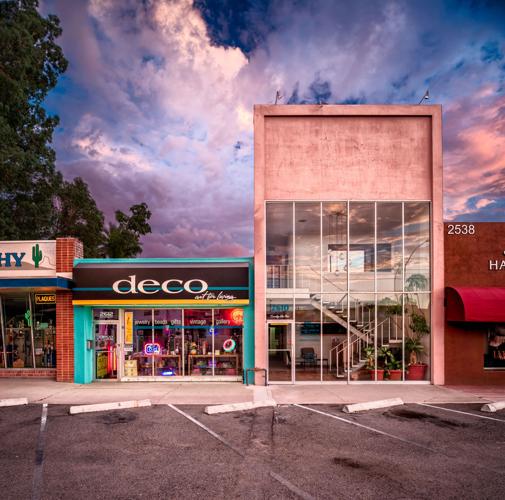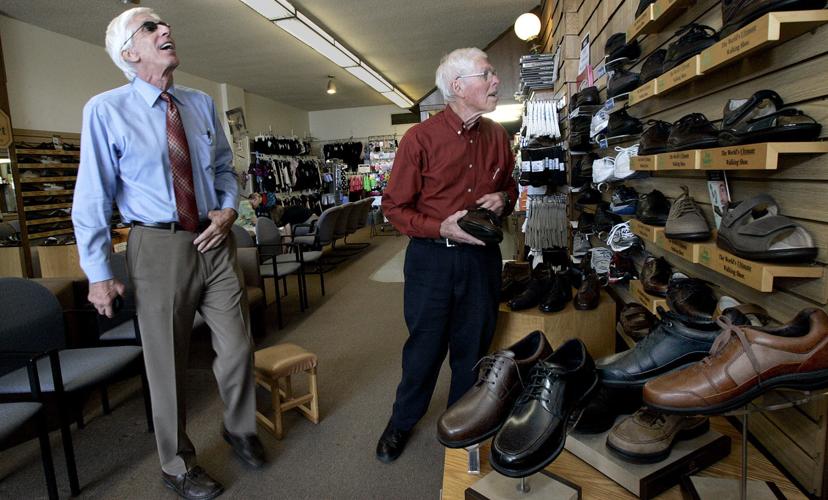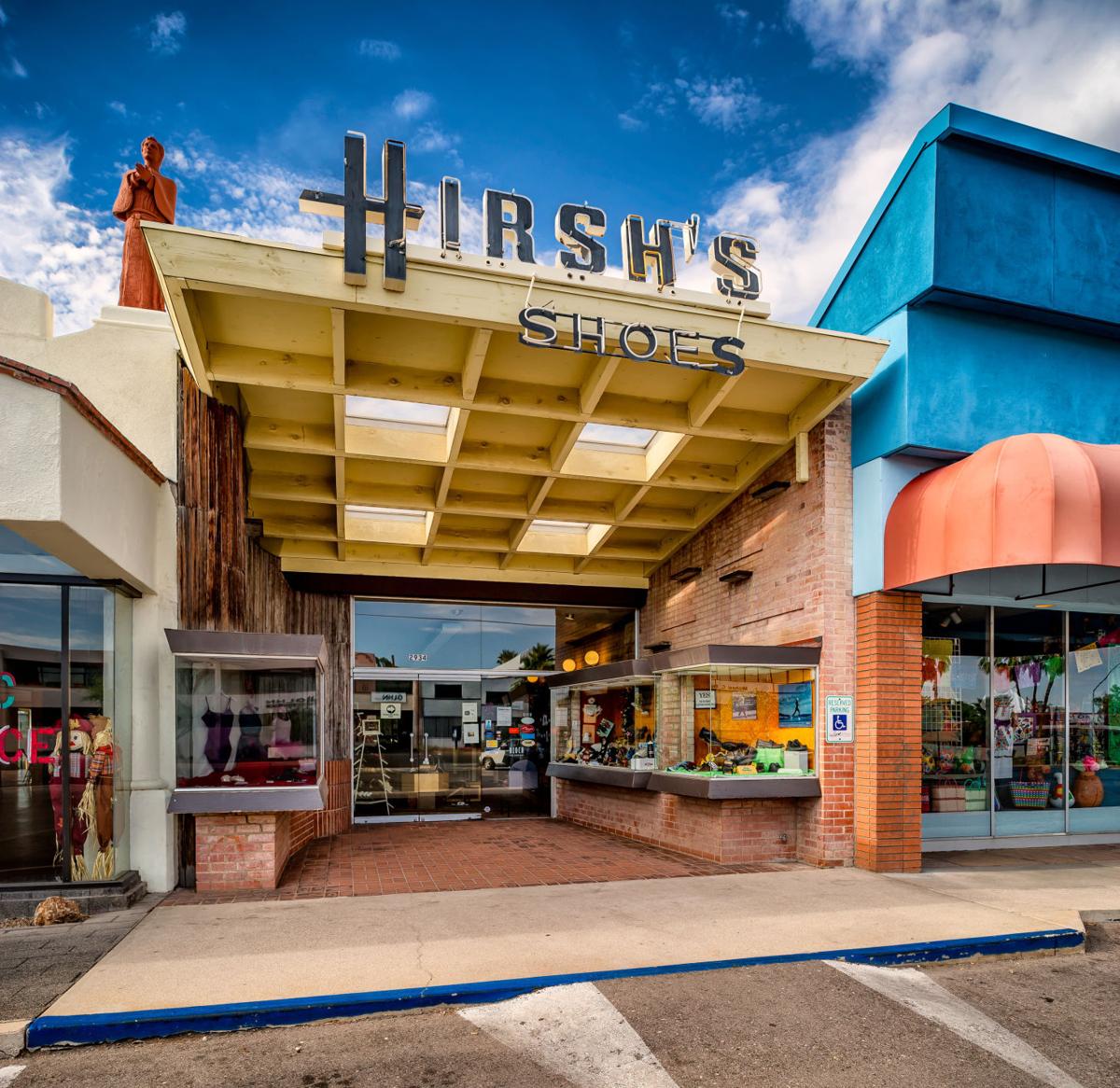Here’s something that will make some longtime Tucsonans feel old: That store on Broadway near Country Club Road where they used to buy shoes was just added to the National Register of Historic Places.
The new designation is expected to help preserve — and maybe rejuvenate — about 160 historic mid-20th-century buildings along a stretch of East Broadway known as the Sunshine Mile, one of Tucson’s first high-end suburban shopping districts.
Iconic locations in the area include the old Valley National Bank, Barrow’s Furniture, Solot Plaza and Hirsh’s Shoes, which closed in 2016 after 62 years in business.
Distinctly modern for their time, the structures incorporated clean, open, geometric designs built out of new construction materials and postwar optimism for the American dream.
The National Park Service officially added the Sunshine Mile to the National Register on May 26, two years after the area was nominated by the Tucson Historic Preservation Association. Demion Clinco, CEO of the nonprofit foundation, said it was the culmination of about six years of work, thousands of volunteer hours and financial support from private contributions.
“It’s not like you check a box and send in a form. We produced a 100-page report,” he said.
They also assembled detailed historic inventories for each property, complete with photos and any available blueprints.
The historic district is roughly 2 miles long and three-quarters of a mile wide, and it takes in more than 200 structures, roughly 80% of which are what Clinco called “contributing historical buildings.”
The new designation qualifies historic properties in the district for a tax credit of up to 20% for renovations.
“It really brings an incentive for the rehabilitation and preservation of these buildings,” Clinco said.
Maybe, he said, “this is how we revitalize this part of our city.”
“preservation by neglect”
Businesses in the area could use the help.
Right now, Clinco said, the Sunshine Mile is “underutilized,” which is putting it kindly. Though a handful of businesses continue to flourish there, empty storefronts line both sides of Broadway, where the north side of the road has been reduced to an open construction trench by long-awaited widening work.
The roughly $71 million road project, approved by voters in 2006, will eventually expand Broadway to six lanes — with medians, bike lanes, bus pullouts and sidewalks — from Euclid to Country Club.
Construction began in January and is expected to last until September 2021.
The city has been promising — or maybe threatening, depending on your point of view — to widen Broadway for decades. The original plan, first floated in the 1980s, called for an eight-lane expansion that would have wiped out everything on the north side of the boulevard.

The Welcome Diner, built in 1964 as Sambo’s Pancake House, is on the western end of Tucson’s historic Sunshine Mile.
City officials marked the proposed right of way on a map and refused to grant permits to anyone who wanted to build or expand along that dotted line, Clinco said. Cautious merchants put off renovation plans or relocated altogether.
The only original Sunshine Mile business Clinco says he knows of that is still in operation is Inglis Florists at 2362 E. Broadway.
“For 30 years we saw a slow disinvestment on Broadway,” he said. “On the flip side, as a result, we saw these buildings and this architecture preserved. It was almost like preservation by neglect.”
The road widening was eventually scaled back somewhat and Rio Nuevo stepped in to save commercial buildings and historic bungalows previously slated for demolition.
After the road work is finished, the tax-supported urban improvement district will guide the renovation — and even relocation — of some of the buildings, all in keeping with the character of the area’s newly recognized historical significance.
Shiny new district for a desert metropolis
Businesses began to spring up along East Broadway in the late 1940s as part of the suburban expansion that marked Tucson’s post-World War II boom.
From 1940 to 1960, the population exploded from less than 36,000 to almost 213,000 as the city pushed largely eastward from the downtown core.
Clinco said that’s when Tucson went from a “small adobe hamlet out in the middle of nowhere” to a desert metropolis.
The shopping district officially became known as the Sunshine Mile in 1953, after the East Broadway Improvement Association held a citywide naming contest. Edward Becker, a staff sergeant with the 803rd bomb wing at Davis-Monthan Air Force Base, submitted the winning entry, beating out 5,000 other competitors to take home the $700 prize.
Some of the businesses that opened on East Broadway early on still maintained their downtown locations. These were their “suburban outlets,” Clinco said with a laugh. “Today it seems funny because it’s so close to downtown.”

The distinctive Chase Bank at Broadway and Country Club was once a Valley National Bank. It was designed by Don Smith of Friedman and Jobusch Architects in 1971.
Then there’s the history within the history.
Clinco said many prominent Jewish merchants and professionals set up shop along the Sunshine Mile, and a number of religious and civic buildings were constructed in and around the district, among them Temple Emanu-El and two different Tucson Jewish Community Centers.
Jewish developer Benjamin H. Solot, the principal of Solot Realty, developed and built at least 17 commercial buildings in the district, including his own office. Jewish architect Bernard Friedman and his Sunshine Mile-based firm Friedman and Jobush designed 29 of the district’s buildings.
Clinco said a host of other innovative and well-known architects also left their mark on the Mile, including Anne Rysdale, Arizona’s only female registered architect at that time.
If he had to pick a favorite building, Clinco said it would probably be the Valley National Bank — now a Chase Bank — at Broadway and Country Club. The distinctive white building was designed by Don Smith of Friedman and Jobusch Architects in 1971.
“I love that bank,” Clinco said. “It almost raises architecture to sculpture.”
Merchants hopeful for a turnaround
Even longtime Tucsonans can be forgiven for not remembering the Sunshine Mile. Though the nickname appeared often in newspaper advertisements and business stories throughout the 1950s, it gradually faded from use after that.
“As the city grew, the street was just absorbed into the urban fabric and forgotten,” Clinco said.
A group of area merchants banded together in 2012 to try to bring the name back by handing out tour maps and painting a Sunshine Mile mural on the historic Haas Building at 2610 E. Broadway.
Monica Hay Cook spearheaded that effort from the art and collectibles shop she used to own next to the Haas Building. Her husband, Jude Cook, painted the mural. Now the couple own two businesses — a sign company and the Ignite Sign Art Museum — south of Broadway but still inside the historic district.
Hay Cook said it’s “just fantastic” to see the area listed on the National Register. She’s hoping the designation will draw tourists, shoppers and investors to the area, providing a much-needed boost to small businesses that are weathering both a major road project and a pandemic.
“We need preservation,” Hay Cook said. “People enjoy that part of Tucson. It’s what makes us unique.”
In 2012, the Arizona Preservation Foundation added the Sunshine Mile to its list of the most endangered historic places in the state. In 2016, the National Trust for Historic Preservation ranked the mid-century business district on Broadway as one of the nation’s 11 most imperiled sites.
Tucsonans walked the Mile in his shoes
It’s hard to think of anyone who has spent more time on the Sunshine Mile than Sid Hirsh.
His mother, Rose, opened a children’s shoe store at 2934 E. Broadway in April 1954. When he got out of the Army later that year, Hirsh joined her at the store and never left.
There were as many as five Hirsh’s Shoes locations in Tucson at one time, but the business gradually shrank back to a single shop at the original location, specializing in shoes for dancers and people with hard-to-fit feet.
In later years, it was just Sid, his dedicated staff and his loyal customers.
“It was a great store,” he said. “I was just lucky to have such great people.”
Hirsh retired from selling shoes in 2016 at the age of 85. The Tucson Historic Preservation Association now owns the shop.

Sid Hirsh, right, owner of Hirsh’s Shoes in Tucson, helps his brother Bob find a new pair. Sid retired in 2016; the Tucson Historic Preservation Association now owns the shop.
“You can’t fight the clock,” said Hirsh, who will celebrate his 90th birthday in October.
His one regret was not being able to persuade any of his children or grandchildren to follow in his shoe prints. He said he’d hoped to see the shop passed down to a third generation of Hirshes some day.
“So much for that,” he said.
construction cones now, Followed by a new dawn
Though it has certainly seen its ups and downs, Hirsh still believes in the Sunshine Mile.
“It’s just a nice neighborhood. If you’ve got a place with the right merchandise and the right look to it, people will want to come to it,” he said.
Ultimately, Hirsh thinks the new historic designation will be a good thing for the area, though he wonders what will be left of the place when all the road work is finished.
Hirsh said he opposed the plans to widen Broadway from the start, and so did many of the neighboring business owners and residents.
Instead, he pushed for a trolly to be built to carry people back and forth between the east side and downtown.
“But the car people really run this city,” Hirsh said. “I think it’s going to be a disaster.”

Anne Rysdale was Arizona’s only female registered architect when she developed and built the Haas Building in 1957.
Hay Cook was never a big fan of the widening project either, and she still isn’t. But she’ll be glad when it’s finally done.
“At the end of this, I think it will be nice,” she said.
“I’m hearing that there’s interest already from businesses that want to come and from businesses that are already there and want to stay.”
Maybe it will even mean the dawn of a new day for the Sunshine Mile.
“For so many years, it didn’t seem like we were in people’s thoughts,” Hay Cook said. “We hope now more people hear about us.”


